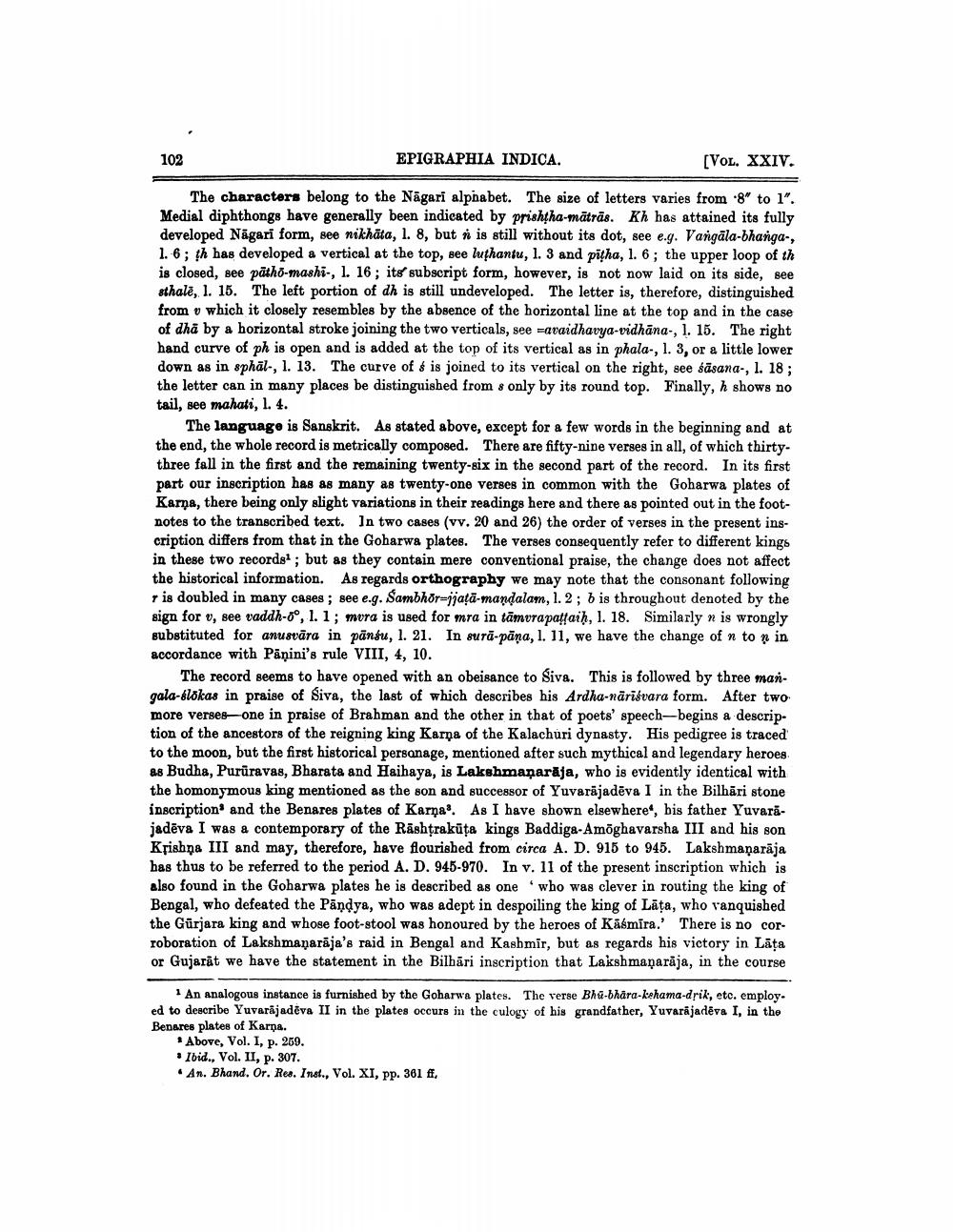________________
102
EPIGRAPHIA INDICA.
[VOL. XXIV.
The characters belong to the Nāgari alphabet. The size of letters varies from 8" to 1". Medial diphthongs have generally been indicated by prishtha mätrās. Kh has attained its fully developed Nägari form, see nikhäta, 1. 8, but A is still without its dot, see e.g. Vangāla-bhanga-, 1. 6; th has developed a vertical at the top, see luthantu, 1. 3 and pitha, 1. 6; the upper loop of th is closed, see pätho-mashi-, l. 16; its subscript form, however, is not now laid on its side, see sthalë, 1. 16. The left portion of dh is still undeveloped. The letter is, therefore, distinguished from v which it closely resembles by the absence of the horizontal line at the top and in the case of dhā by a horizontal stroke joining the two verticals, see ravaidhavya-vidhāna-, 1. 15. The right hand curve of ph is open and is added at the top of its vertical as in phala-, 1.3, or a little lower down as in sphäl., 1. 13. The curve of $ is joined to its vertical on the right, see sāsana., 1. 18; the letter can in many places be distinguished from s only by its round top. Finally, h shows no tail, see mahati, 1. 4.
The language is Sanskrit. As stated above, except for a few words in the beginning and at the end, the whole record is metrically composed. There are fifty-nine verses in all, of which thirtythree fall in the first and the remaining twenty-six in the second part of the record. In its first part our inscription has as many as twenty-one verses in common with the Goharwa plates of Karna, there being only slight variations in their readings here and there as pointed out in the footnotes to the transcribed text. In two cases (vv. 20 and 26) the order of verses in the present inscription differs from that in the Goharwa plates. The verses consequently refer to different kings in these two recordel; but as they contain mere conventional praise, the change does not affect the historical information. As regards orthography we may note that the consonant following
is doubled in many cases; see e.g. Sambhor=ijatā-mandalam, 1.2; b is throughout denoted by the sign for v, see vaddh-6°, 1.1; mora is used for mra in tamurapattaiḥ, 1. 18. Similarly n is wrongly substituted for anusvāra in pansu, l. 21. In surā-pāņa, 1. 11, we have the change of n to n in accordance with Pāņini's rule VIII, 4, 10.
The record seems to have opened with an obeisance to Siva. This is followed by three man. gala-blokas in praise of Siva, the last of which describes his Ardha-nārisvara form. After two more verses-one in praise of Brahman and the other in that of poets' speech-begins a description of the ancestors of the reigning king Karna of the Kalachuri dynasty. His pedigree is traced to the moon, but the first historical personage, mentioned after such mythical and legendary heroes 88 Budha, Purüravas, Bharata and Haihaya, is Lakshmañarāja, who is evidently identical with the homonymous king mentioned as the son and successor of Yuvarājadēva I in the Bilbāri stone inscription and the Benares plates of Karna. As I have shown elsewhere, bis father Yuvarā. jadēva I was a contemporary of the Rashtrakūta kings Baddiga-Amõghavarsha III and his son Krishna III and may, therefore, have flourished from circa A. D. 915 to 945. Lakshmanaraja has thus to be referred to the period A. D. 945-970. In v. 11 of the present inscription which is also found in the Goharwa plates he is described as one who was clever in routing the king of Bengal, who defeated the Pandya, who was adept in despoiling the king of Lāta, who vanquished the Gürjara king and whose foot-stool was honoured by the heroes of Kāśmira.' There is no corroboration of Lakshmanarāja's raid in Bengal and Kashmir, but as regards his victory in Lata or Gujarat we have the statement in the Bilbāri inscription that Lakshmanarāja, in the course
1 An analogous instance is furnished by the Goharwa plates. The verse Bha-bhara-kehama-drik, eto. employ. ed to describe Yuvarājadēva II in the plates occurs in the culogy of his grandfather, Yuvarājadeva I, in the Benares plates of Karna.
* Above, Vol. I, p. 269. • Ibid., Vol. II, p. 307. • An. Bhand. Or. Res. Inst., Vol. XI, pp. 361 ff.




